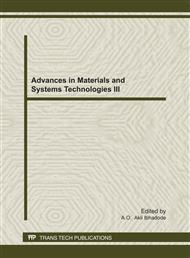p.3
p.13
p.19
p.27
p.33
p.41
p.49
p.55
p.63
Cost Effectiveness of Scheffe’s Optimized Five-Component-Concrete with Mound Soil as a Mix Component
Abstract:
The paper examined the cost benefit of optimized five-component-concrete mix. Mound Soil randomly selected from Iyeke-Ogba in Benin City was used as a case study of a fifth component in the concrete mix. The work applied Scheffe’s optimization technique to obtain concrete mix proportions. A mathematical model for the optimizing concrete of five components namely; cement, fine aggregate, mound soil, coarse aggregates and water/cement (w/c) ratio, was developed. Cube samples measuring 150mm x 150mm x 150mm were made with the developed mixes and compared with the results of a standard 1:2:4 mix. The samples were tested at 7, 14 and 28 days for compressive strength. The costs of producing a unit volume of the concretes were determined and compared. The results showed that the standard mix gave a 28th day maximum strength of at a w/c of 0.5 and the theoretically optimized design mix gave a mix proportion of 1.00:1.59:0.46:3.34:0.53 and a compressive strength of. This mix was tested experimentally and it gave, representing an increase of 15.33%. The cost benefit analysis showed that Scheffe’s optimized mound soil concrete, MSC was 15% more economical than the standard mix plain concrete.
Info:
Periodical:
Pages:
33-40
Citation:
Online since:
October 2011
Authors:
Keywords:
Price:
Сopyright:
© 2012 Trans Tech Publications Ltd. All Rights Reserved
Share:
Citation:


